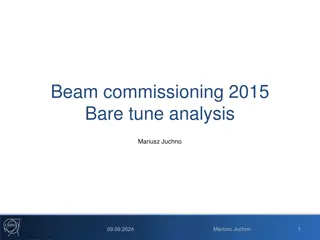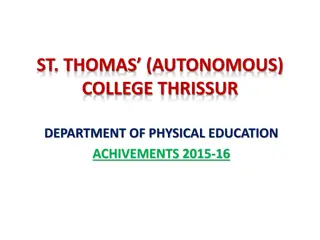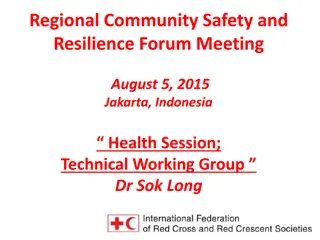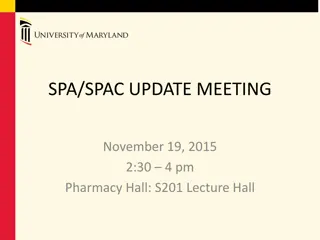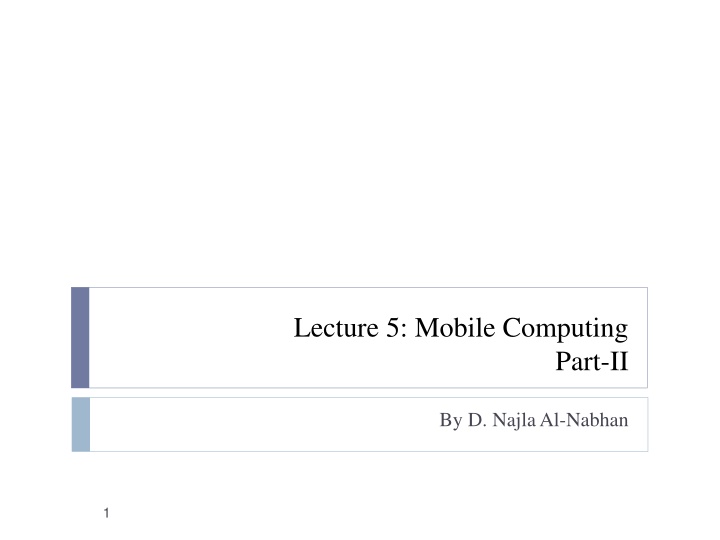
Evolution of Mobile Computing and Wireless Technologies
Explore the development of wireless technologies from the 1980s, the architecture of existing cellular networks, mobile communication overview, and the future of compact mobile computing devices. Learn about the history, network architecture, and models shaping mobile computing. Discover the potential for compact mobile computers with advancements in AI technology.
Uploaded on | 1 Views
Download Presentation

Please find below an Image/Link to download the presentation.
The content on the website is provided AS IS for your information and personal use only. It may not be sold, licensed, or shared on other websites without obtaining consent from the author. If you encounter any issues during the download, it is possible that the publisher has removed the file from their server.
You are allowed to download the files provided on this website for personal or commercial use, subject to the condition that they are used lawfully. All files are the property of their respective owners.
The content on the website is provided AS IS for your information and personal use only. It may not be sold, licensed, or shared on other websites without obtaining consent from the author.
E N D
Presentation Transcript
Lecture 5: Mobile Computing Part-II By D. NajlaAl-Nabhan 1
History of Wireless Technologies Development (1980-200?) 2
EXISTING CELLULAR NETWORK ARCHITECTURE A cellular network consists of mobile units linked together to switching equipment, which interconnect the different parts of the network and allow access to the fixed Public Switched Telephone Network (PSTN). It's incorporated in a number of transceivers called Base Stations (BS). Every BS is located at a strategically selected place and covers a given area or cell - hence the name cellular communications. A number of adjacent cells grouped together form an area and the corresponding BSs communicate through a so called Mobile Switching Centre (MSC). 3
EXISTING CELLULAR NETWORK ARCHITECTURE The MSC is the heart of a cellular radio system. MSC is responsible for routing, or switching, calls from the originator to the destination. managing the cell, for set-up,routing control and termination of the call, for management of inter-MSC hand over and supplementary services, and for collecting charging and accounting information. The MSC may be connected to otherMSCs or to the PSTN. 4
Mobile communication overview Each cell has a number of channels associated with it. When a Mobile Station (MS) becomes 'active' it registers with the nearest BS. The corresponding MSC stores the information about that MS and its position. This information is used to direct incoming calls to the MS. If during a call the MS moves to an adjacent cell then a change of frequency will necessarily occur - since adjacent cells never use the same channels. This procedure is called hand over and is the key to Mobile communications. 5
History of Wireless Technologies Development (1980-200?) 6
Simple Reference Model for mobile computing 7
The Future With the emphasis increasingly on compact, small mobile computers, it may also be possible to have all the practicality of a mobile computer in the size of a hand held organizer or even smaller. With the rapid technological advancements in Artificial Intelligence, Integrated Circuitry and increases in Computer Processor speeds, the future of mobile computing looks increasingly exciting. Use of Artificial Intelligence may allow mobile units to be the ultimate in personal secretaries, which can receive emails and paging messages, understand what they are about, and change the individuals personal schedule according to the message. The working lifestyle will change, with the majority of people working from home, rather than commuting. This may be beneficial to the environment as less transportation will be utilized. 9
The Future As shown in the figure, trends are very much towards ubiquitous or mobile computing. Interactive television, Video Image Compression, mobility in the home, ie. home shopping etc. this mobility may be pushed to extreme. The future of Mobile Computing is very promising indeed, although technology may go too far, causing big changes to society. 10
Quiz Next Lecture 11

